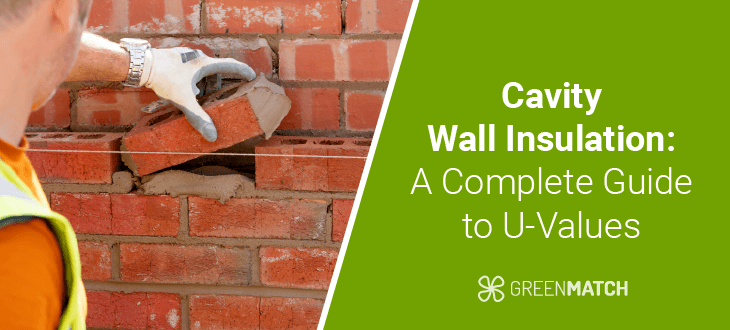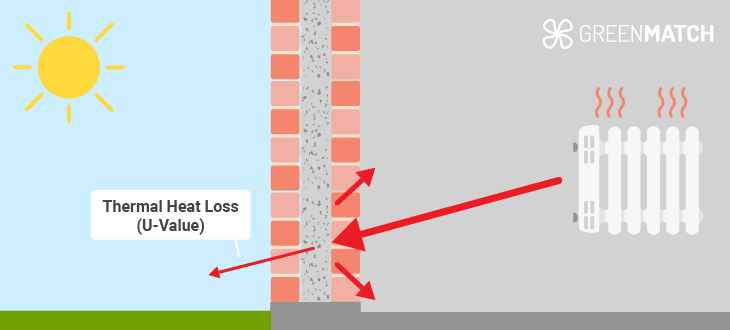Answer these simple questions and we will find you the BEST prices
Which type of solar quotes do you need?
It only takes 30 seconds
100% free with no obligation

Get Free quotes from loft conversion specialists near you

Save money by comparing quotes and choosing the most competitive offer

The service is 100% free and with no obligation
- GreenMatch
- Insulation
- Wall Insulation
- Cavity Wall Insulation
- Cavity Wall U-value
Cavity Wall Insulation U-Value Explained: How Does It Work?


- The U-value is a measure of how effective a material is in preventing heat transfer. In other words, how good it is at insulating.
- The U-value of a material is calculated as U-value = 1/(Sum of all R-value).
- The Approved Documents L (ADL) in England expect a U-value of at least 0.18 W/m2K for an insulated cavity wall.
U-value, sometimes also called thermal transmittance, tells us about how well a material is in resisting heat transfer. The value itself shows us the rate at which heat transfer takes place, so a lower U-value means a better-insulated structure.
With the dwindling efficiency of the UK housing stock becoming a focus point on the path to Net Zero emissions by 2050, homes nationwide are getting insulated to improve their thermal efficiency. U-value is an important indicator of how effectively a home is insulated.
This ultimate guide by GreenMatch UK will break down everything there is to know about U-value in regards to wall cavity insulation, including what u-value should be achieved, any regulations governing this, and how to improve u-value.
Ready to get cavity wall insulation? Look no further than GreenMatch UK for a one-stop solution to all your needs. Instead of spending countless hours researching and vetting installers, simply spend 30 seconds filling out our online form and receive up to 3 free home-tailored quotes delivered right to you. Click the button below to begin!
Fill in the form in just 1 minute
What is the u-value for your cavity wall?

If you’re wondering what is u-value insulation, we’ll break it down for you. The U-value for a cavity wall, or any material, tells you how well it is at resisting heat transfer. In other words, the U-value measures how well of an insulator a material is.
An average cavity wall has a U-value of about 1.6 W/m2k before being insulated and can be improved up to 0.6 - 0.18 W/m2K after proper cavity wall insulation.
If you notice, an improved U-value is lower in rate. As in, low U-value insulation is better at resisting heat transfer. This is because the U-value shows us the rate of heat transfer per metre and hour. A lower U-value indicates less heat transfer, which indicates a better insulating capacity.
How do you calculate your cavity wall insulation u-value?
Simply put, a cavity wall insulation U-value is calculated by the formula U = 1/(Sum of all R-value). In this case, the R-value is a sort of opposite of the U-value. So R = 1/(Sum of all U-value). They are inverses of each other. To eliminate the confusion, we've created the r-value insulation chart in the UK so you can compare and spot the differences.
While the R-value also tells us about how good a material is at resisting heat transfer, it’s considered to be the flipped version, which means a higher R-value means the material is better at resisting heat transfer.
Makes sense? Probably not, but don’t worry if it doesn’t! Understanding how these values are calculated is nowhere near as important as understanding what they represent.
What is a good u-value for my cavity wall insulation?
Now that we know a lower U-value means a material is better at insulating, cavity wall insulation aims to lower the U-value of your cavity walls.
In this case, common building regulations throughout the UK recommend aiming for a U-value of 0.6 - 0.18 W/m2K after installing cavity wall insulation. This is compared to an average U-value of around 1.6 W/m2k for uninsulated cavity walls.
This is a drastic drop from the U-value of an uninsulated wall, showing just how much better these walls become at resisting heat transfer with proper insulation measures.
Are there any regulations on the u-values of my cavity wall insulation?

The UK Building Regulations 2010 document outlines U-value expectations for the conservation of fuel and power in domestic housing and commercial properties.
Most of these cavity wall insulation regulations tend to focus on new builds instead of existing structures, but may still be relevant if you plan on constructing a new home.
According to the updated Part L section of the document, the expected U-value for external walls and cavity walls are:
- New builds: 0.18 W/m2K
- Existing structures: 0.18 W/m2K
- Extensions to existing structures: 0.30 W/m2K
Builders, contractors, and insulation experts need to be aware of these regulations to make sure they are complied with. For that reason, it’s very important to work with a professional installer. That way, you can make sure to receive a quality job that is in line with government expectations.
However, finding the perfect installer can be a daunting job that consumes many hours of research and vetting. That’s where GreenMatch UK can help you out.
Instead of spending endless hours on websites and phone calls, just spend 30 seconds filling out our simple online form, and receive up to 3 free home-tailored quotes from our nationwide network of accredited installers. No extra charges and non-binding. Click the button below to begin!
Fill in the form in just 1 minute
FAQ
The u-value of a cavity wall is usually around 1.6 W/m2k before insulation and can be improved up to 0.6 – 0.18 W/m2K after proper cavity wall insulation is installed.
The u-value for walls in the UK can vary based on several factors: whether it’s a solid or cavity wall, whether it’s a new build or old property, and whether it’s insulated or not.
However, the general u-value for a standard cavity wall is around 1.6 W/m2k, and all walls – cavity or solid – are expected to reach around 0.18 W/m2K after insulation.
Existing building extensions are expected to achieve a u-value of around 0.30 W/m2K at the very least, and a desirable 0.18 W/m2K in the best-case scenario.
A standard solid brick or masonry wall usually has an average u-value of around 2 W/m2K. This is significantly higher than average cavity walls and is usually attributed to the fact that such buildings tend to be much older. After insulation, an external wall u-value should also reach around 0.18 W/m2K in the best-case scenario.

Akif is a copywriter at GreenMatch since 2023. With a keen interest in community sustainability, green solutions and the role of digital media in identifying climate trends, he aims to hone in on his background in International Studies and Digital Media to provide a multidisciplinary approach to written content rooted in credible research and accuracy.
We strive to connect our customers with the right product and supplier. Would you like to be part of GreenMatch?

